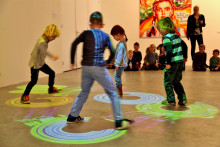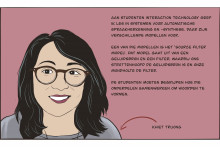Robby van Delden from the HMI (Human Media Interaction) group is defending his PhD thesis tomorrow. He is using the occasion to also organize the symposium The Power of Play, where several prominent speakers will talk about various aspects of interactive playful activities.
Advanced game of tag
‘Technology mediates how we interact and behave. It also mediates our play activities and in this way changes how people play. We can use this to encourage – or “steer” - wanted types of behaviors,’ Robby van Delden describes his PhD work titled ‘(Steering) Interactive Play Behavior’.
Van Delden developed several interactive systems focused on different target groups. One example is the interactive tag playground that tracks players and provides an interactive floor projection. ‘We can use the platform to steer the players towards better social interaction. For example, when children play, there is often a shy child, who just stays on the side and doesn’t get tagged. We can use this interactive platform to draw attention to the child and make them feel included,’ he says.

Photo by: Hetty de Vries
Interactive ball
Within his PhD research, Van Delden also worked on an interactive ball that responds to body movements and sounds with its own movements, tunes, and lights. This device was meant as a leisure activity for people with profound intellectual and physical disabilities. ‘People with such disabilities can’t communicate by talking, but only use non-verbal communication. We thought that such an interactive ball could therefore increase their alertness of the world, make them happier and less agitated,’ says Van Delden.
‘After testing the ball, we found out that it doesn’t work for everyone, but some users responded very positively to it. It’s a very small change in their lives, but it makes a huge difference, because they don’t have that many options how to interact and spend their time.’

Games for gait rehabilitation
As mentioned, Robby van Delden has also been busy with developing a pressure sensitive LED floor that you can play games on. ‘This floor is intended for gait rehabilitation, such as for patients after stroke, who are learning how to walk again,’ he says. ‘It allows them to learn to walk in a stimulating and fun way. There is a number of games they can choose from and they can adjust the game’s settings like the size of steps or speed. This ensures that the game is truly appropriate for the given patient.’
The next step is to test this LED floor in practice. ‘That is what we are working towards,’ confirms Van Delden. ‘You could do really awesome things with it, but first we need to see how it works in real-life scenarios.’
How to steer?
‘The main goal of my research was to investigate how we can introduce new interactions into play and steer behavior with technology,’ continues Van Delden. ‘Our investigations showed we can steer interactive play behavior in different ways. On the one hand, we steered behavior by forcing game rules upon users. For instance, creating a game mechanic that makes players score points only when they are staying close to their team mate. On the other hand, we steered behavior in a more subtle way by enticing players. For instance, providing non-functional embellishments for the optional collection of items.’
Symposium
If you would like to know more about Robby van Delden’s work and the topic of interactive play, you can still sign up for the symposium The Power of Play that Van Delden is organizing tomorrow after his PhD defense. More information can be found here.









